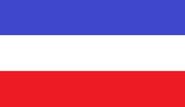Template:Front/featured/Skundavisk
| Skundavisk | |
|---|---|
 Flage af Skundafland | |
| Pronunciation | [ʃʊndaβɪʃ] |
| Created by | Mohamed Kaseb |
| Date | 2008 |
| Setting | Wikselgeskighte Jurve, NorþerDietskland |
| Native to | Skundafland |
Indjurvisk
| |
Early form | Orwestgermannisk
|
Dialects |
|
Skundavisk (sh.: /ʃʊndaβɪʃ/), also known by its anglicized name Shoundavish, is a Germanic constructed language created by Mohamed Kaseb. Designed as a West Germanic language, it has been developed from the Old Saxon dialects spoken in what is now Schleswig and Holstein in the early Middle Ages, and is thus closely related to English, Dutch, Low Saxon, the Frisian languages and (High) German. Shoundavish also underwent a slight North Germanic influence due to contacts with the Nordic countries, which is reflected by the presence of Scandinavian loanwords in its vocabulary, especially from Old Norse and Early Modern Danish. Consequently, despite being a West Germanic language, Shoundavish shares some similarities with Danish, Swedish and Norwegian, especially in phonology and vocabulary.
Shoundavish didn't take part in the High German consonant shift, and is overall one of the most conservative Germanic languages regarding the consonants. Because of its preservation of the sounds /θ/, /ð/ and /w/, along with a large common vocabulary, Shoundavish is one of the closest languages to English. However, both languages underwent very different vowel shifts over time, which makes them sound quite different. Besides, while English borrowed many words from the Romance languages (especially French), the Shoundavish vocabulary remained mostly Germanic, and very few words were borrowed from non-Germanic sources. Therefore, words like "biology" or "litterature" are built using Germanic roots instead of Latin or Greek ones. While being very conservative in its phonology and lexicon, Shoundavish didn't preserve the complex grammar of Proto-Germanic, and the medieval case system has been reduced to scattered remnants in the modern language.